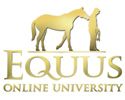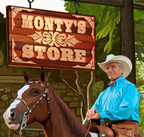Hi,
I am looking at buying hay for the winter and I had a little trouble finding sellers. I came across Mid-America auctions co. that have hay auctions every month in fall/winter. They have a good reputation and test the hay for nutrients, moisture, etc. The trouble is is that they sell hay by the ton and I have no idea how much I should get. I did some math and assuming each of my 3 horses ate about 22lbs a day for 220 days of the year it would come out to 14,520lbs which is 7.26 tons... anyone buy hay by the ton?? or buy round bales and know about how much they weighed? I bought 18 round bales last year but I am not exactly sure of there weight. I just want to make sure that I buy enough, I would prefer to have too much than too little. Thank you for any help :]
← back
Horse Care and Comfort
buying hay by the ton...

Rewards
Subscribe to Equus Online University and become a part of Monty's worldwide mission to leave the world a better place for horses and for people too.
Students automatically gain access to special rewards, such as exclusive discounts at the Monty Roberts Online Shop. Visit Monty Roberts Online Shop.



Hi Almira94,
I'm not sure what your question is, but I can tell you of my experience with round bales - I assume you mean the plastic-wrapped haysilage bales.
.
The yard where I keep my horse buy haysilage by the ton from a nearby farmer. He have different sizes of bales ranging between 50kg to 500kg (half a ton). The weight does vary a bit depending on the amount of moisture, but the seller should be able to tell you the estimated weight of a certain size.
We prefer the smaller bales, since they (preferably)should be used up within a certain amount of time, and are easier to handle.
.
Tests are vital when you want to calculate the amount of feed for each horse, esp. with haysilage where it is almost impossible to get them once the hay is baled up.
For example; if you buy haysilage with a dry content between 55-65% you need to feed the horses almost twice as much haysilage as if you gave them "ordinary" hay.
.
It's very wise to have a bit too much, since quite a bit will get lost if they are fed outdoors (trampled into the ground) or the odd bale going bad.
.
Also, you might want to consider vaccinating your horses against Botulism, which is a risk with haysilage with a dry content below 70%.
.
Storage wise, the round bales have a lot of advantages, but personally I prefer "real" hay since the amount of horses diagnosed with laminitis has sky rocketed here since haysilage became more used as feed.
.
I don't know if this was of any help, but I wish you the best of luck with the hay!
Thank you for all this info! I was mostly wondering how much I should buy because I have never bought by the ton before, I would be buying mixed grass hay. I actually didn't know that you could feed haysilage to horses, I know that is what all the farmers around here feed their cows. But I will defiantly watch the moisture, I wasn't aware horses could get Botulism from the haysilage and/or hay. Since I only have 3 horses I usually tear apart the round bales and take it in like that, just to check for mold and to get any dust out of it. Thank you for you help :)
Hi Almira24,
I too was told to never feed my horse hayliage. Their stomach cannot handle the richness of the type of grasses it is made from.
Here in Canada it comes from swamp like fields, I'm not sure where it comes from in other countries.
Because we live so close to the ocean the swamp is fed from the salt water and when you smell the hayliage it has the aroma of salt and molasses, not pleasant to me at all.
I like clean fresh hay with lots of green still in it.
My vet told me it would be very bad for STAR and her digestion system if I were to fed her hayliage.
My daughter fed her horses Hayliage for two winters and by the second summer they lost so much weight you could see their hip bones.
I told her what my vet said and she stopped, they gained their weight back, plus.
My horse is of average size and in really good shape, according to her vet, and it was suggested she get 1/2 a bale (70 pound bales) a day.
Maybe you could calculate it by how much they eat daily and then you'll know how much you need. Ask how heavy the bales are.
I know how much she gets because she only has hay when she is in her stall, morning and night. She gets pasture otherwise.
I nor our family farm ever bought hay by the ton, we have always made our own, sorry I can't be of much help.
I'm sure you'll get the advice you need.
Ronda
Hmm, I sense a difference either in use of terminology or the making of haysilage in different countries.
.
I want to stress that the haysilage I am speaking of, has little to do with the ensilage they use for cows, which is fermented in silos, or the *haylage* they pack in plastic bales -usually with some acid to help the fermenting process. The latter is also usually harvested early from a field rich with clover. They are NOT suitable for horses.
.
What we call haysilage (for horses) here is roundbaled hay, harvested no earlier than late June and mostly timothy grass.
.
If I were to buy hay by the ton, I would calculate (loosely) with 10 kg hay/day and horse. 100 days=1 ton/horse. But, of course, that number needs to be adjusted depending on circumstances like type of horse, workload, age, and the nutrient values of the hay and hard feed put together.
Thank you Kicki,
We have those round bales here too.
I don't use them because I only have one horse and I found too much waste so I use the square ones for Star.
Ronda